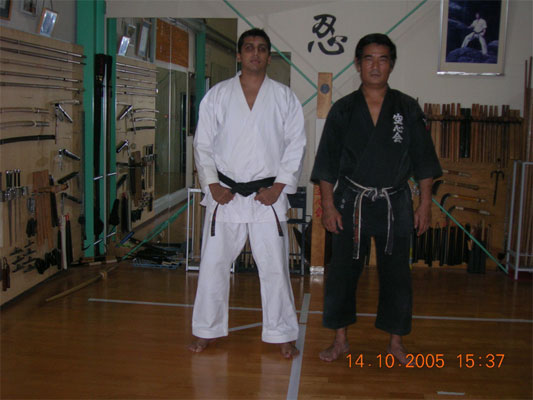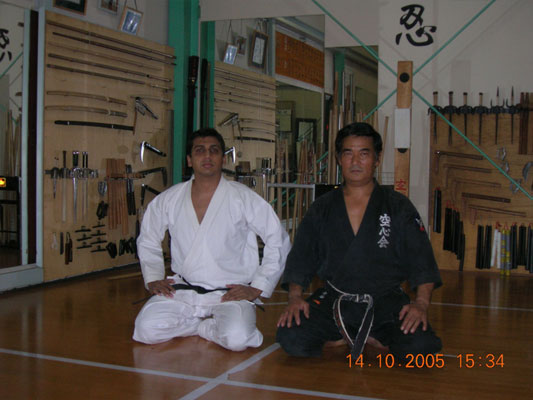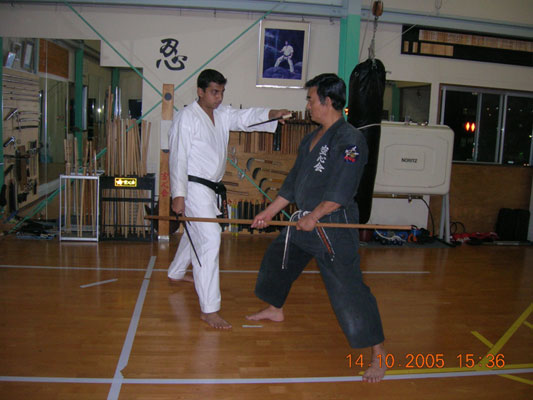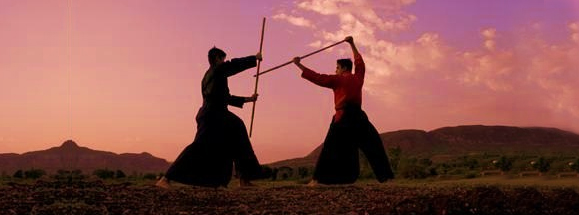Jodo , meaning "the way of the jo", or jojutsu is a Japanese martial art using short staves called jo. The art is similar to bojutsu, and is strongly focused upon defense against the Japanese sword. The jo is a short staff, usually about 3 to 5 feet (0.9 to 1.5 m) long, about the average length of a walking stick. However, the art was not used, as one might fancifully imagine, by travelers to ward off aggressive bandits or swordsmen. The martial art of jodo was the province of professional Samurai warriors.
Shinto Muso-ryu jodo, (formerly Shinto Muso-ryu jojutsu), is reputed to have been invented by the great swordsman Muso Gonnosuke Katsuyoshi (fl. c.1605, date of death unknown) about 400 years ago, after a bout won by the famous Miyamoto Musashi (1584-1645). According to this tradition, Gonnosuke challenged Musashi using a bo, or long staff, a weapon he was said to wield with great skill. Although there are no records of the duel outside of the oral tradition of the Shinto Muso-ryu, it is believed that Musashi caught Gonnosuke's bo in a two sword "X" block (juji-dome). Once in this position, Gonnosuke could not prevent Musashi from delivering a counterattack, and Musashi elected to spare his life.
Gonnosuke then withdrew to a Shinto shrine to meditate. After a period of purification, meditation, and training, Gonnosuke claimed to have received a divine vision. By shortening the length of the bo staff from roughly 185 cm to 128 cm (or, in the Japanese measurements, four shaku, two sun and one bu), he could increase the versatility of the weapon, giving him the ability to use techniques created for the long staff, spearfighting and swordsmanship. The length of the new weapon was longer than the tachi (long sword) of the period, but short enough to allow the reversal of the striking end of the jo in much tighter quarters than the longer bo. Gonnosuke could alter the techniques he used with the jo stick, depending on the opponent he faced, to provide himself with many different options of attack. He named his style Shinto Muso-ryu and challenged Musashi again. This time, when Musashi attempted to use the juji-dome block on the jo staff, Gonnosuke was able to wheel around the other end of the staff (because of the reduced length), forcing Musashi into a position where he had to concede defeat. Returning the courtesy he received during their previous duel, Gonnosuke spared Musashi's life.
This may be a fabricated origin of the creation of jojutsu, as the oral tradition of the Shinto Muso-ryu is the only mention of this duel, or for that matter, a person defeating Musashi in combat. Witness accounts of Musashi's life, as well as his own writings, insist he retired from dueling undefeated. What is known, however, is that Gonnosuke eventually became the martial arts instructor for the Kuroda clan of northern Kyushu, where jojutsu remained an exclusive art of the clan until the early 1900s, when the art form was taught to the general public.
Jodo is a Highly practical art form for the modern age because of its use of the Short staff,Mehul Voraa is a personal student of Shihan Kanaya Jinju and a licensed teacher of the Kushinkai Jojutsu Renmei.
Training with Shihan Kanaya Jinju at Kushinkai Jojutsu Renmei Japan



|



